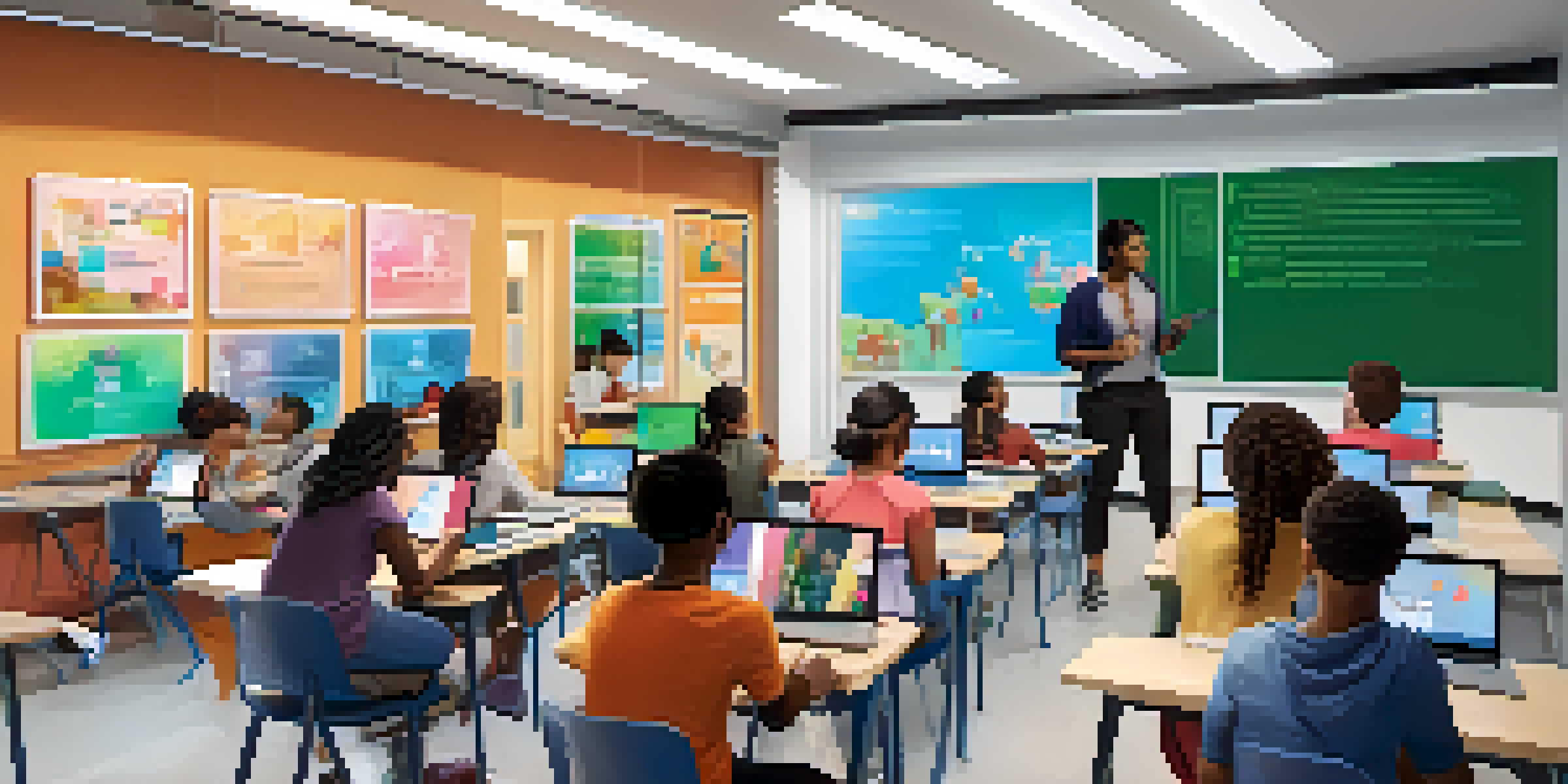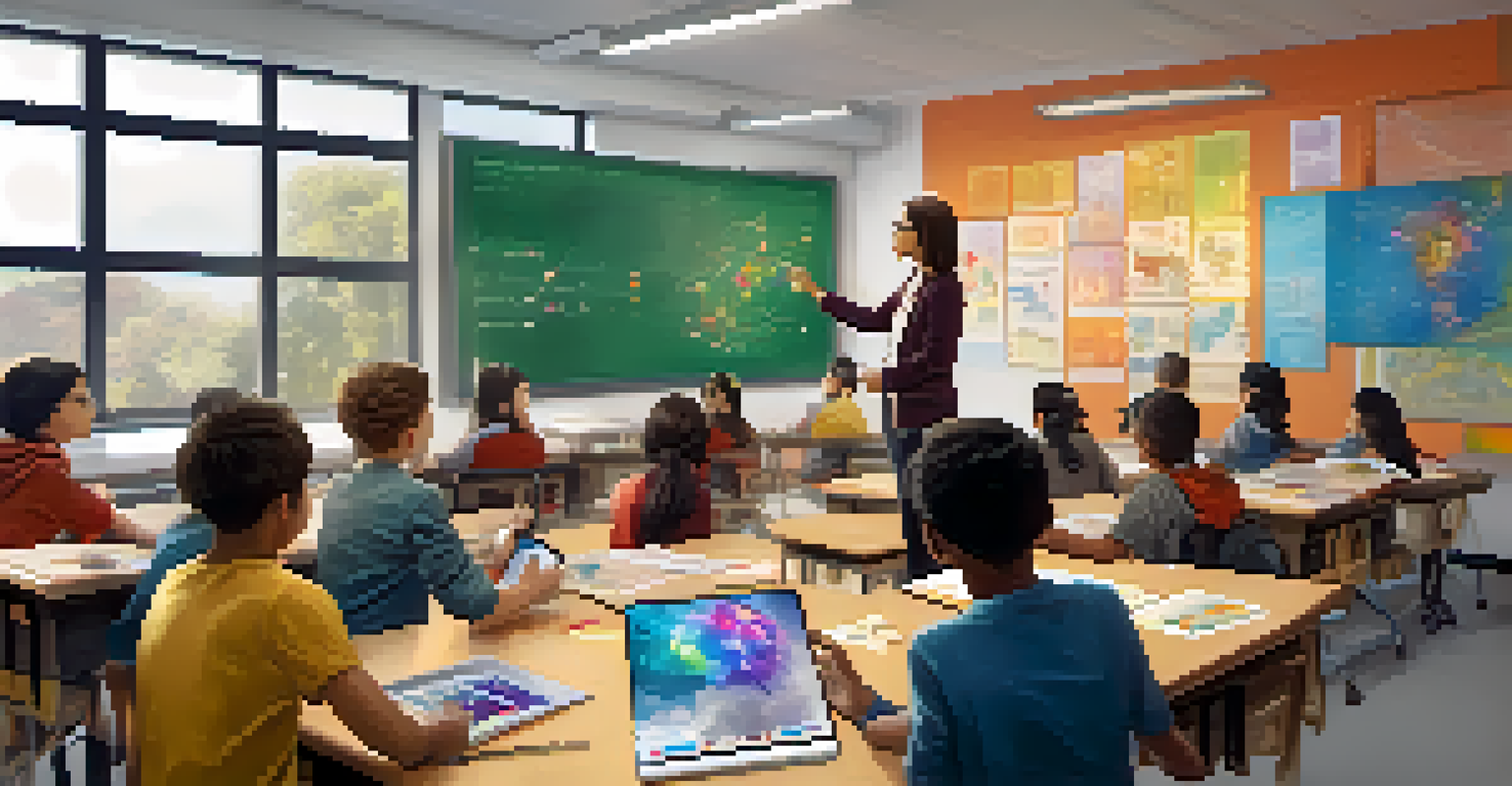AI in Education: Assessing the Impact on Teacher-Student Dynamics

Understanding AI's Role in Modern Education
Artificial Intelligence (AI) has emerged as a transformative force in education, reshaping how teachers and students interact. At its core, AI refers to computer systems that can perform tasks typically requiring human intelligence, such as understanding natural language and recognizing patterns. This technology is being integrated into classrooms, enhancing learning experiences and streamlining administrative tasks.
Education is not the filling of a pail, but the lighting of a fire.
As educators begin to embrace this technology, they can harness AI tools to personalize learning for each student. For instance, adaptive learning platforms analyze student performance and tailor content accordingly, ensuring that every learner can progress at their own pace. This not only fosters better understanding but also cultivates a more inclusive environment where diverse learning needs are met.
Moreover, AI can assist teachers by automating routine tasks, such as grading and attendance tracking. By alleviating these burdens, educators can focus more on teaching and engaging with their students. This shift in dynamics enhances the teacher-student relationship, allowing for deeper connections and more meaningful educational experiences.
Enhancing Student Engagement Through AI Tools
One of the most exciting aspects of AI in education is its capacity to boost student engagement. Interactive AI-driven platforms, like chatbots and virtual tutors, provide instant feedback and support, making learning more dynamic and enjoyable. Imagine a student struggling with a math problem having access to a virtual tutor available 24/7 – that's the power of AI!

These tools can gamify learning experiences, turning traditional lessons into interactive challenges that motivate students to participate actively. For example, language learning apps often include game-like elements, encouraging students to practice without the fear of judgment. This approach not only keeps learners engaged but also promotes a sense of achievement as they progress.
AI Personalizes Learning Experiences
AI tailors education to individual student needs, enhancing understanding and fostering a sense of ownership in their learning journey.
While AI offers these exciting avenues for engagement, it's essential to balance technology with human interaction. Teachers remain vital in guiding discussions and fostering critical thinking. By blending AI tools with personal mentorship, educators can create an enriched learning environment that caters to the needs of all students.
AI's Impact on Personalized Learning Experiences
Personalized learning is a game-changer in the educational landscape, and AI plays a crucial role in its implementation. Through data analysis, AI can identify individual strengths and weaknesses, allowing for tailored lesson plans that cater to each student's unique learning style. This customized approach helps learners grasp complex concepts more effectively.
The great aim of education is not knowledge but action.
For instance, AI-driven systems can suggest resources or exercises that align with a student's current understanding, promoting mastery before moving on to more challenging material. This personalized feedback loop empowers students, encouraging them to take ownership of their learning journey. They no longer feel lost in a one-size-fits-all curriculum.
However, the effectiveness of personalized learning hinges on teachers' ability to interpret AI-generated insights. Educators must be equipped to use this data constructively, ensuring that it informs their teaching strategies. When teachers and AI work in tandem, they can create a powerful synergy that enhances educational outcomes.
The Teacher's Evolving Role in an AI-Driven Classroom
As AI systems become more prevalent in the classroom, the role of the teacher is evolving significantly. Rather than being the sole source of knowledge, educators are transitioning into facilitators of learning experiences. This shift allows them to focus on nurturing critical thinking, creativity, and emotional intelligence in their students.
Teachers are now tasked with guiding students through the vast array of information available, teaching them how to discern credible sources from unreliable ones. This skill is essential in an age where misinformation can spread rapidly. By fostering these competencies, teachers prepare students to navigate the complexities of the digital world.
Teachers Evolve as Learning Facilitators
As AI takes on administrative tasks, teachers are shifting to focus on nurturing critical thinking and emotional intelligence in students.
Moreover, with AI handling administrative tasks, teachers can devote more time to building relationships with their students. This deeper connection can lead to a better understanding of individual needs and learning goals, ultimately enhancing the educational experience. The teacher-student dynamic is thus enriched, creating a more supportive and collaborative learning environment.
Challenges and Concerns of AI in Education
Despite its potential benefits, the integration of AI in education comes with its own set of challenges. One significant concern is data privacy; the collection and analysis of student data raise questions about how this information is used and secured. Parents and educators alike must ensure that AI systems comply with regulations and protect students' sensitive information.
Another issue is the risk of over-reliance on technology. While AI can provide valuable insights, it shouldn't replace human judgment. There’s a danger that educators might lean too heavily on AI recommendations without considering the nuances of individual student circumstances. Balancing AI assistance with personal insight is vital for effective teaching.
Lastly, access to AI tools can be uneven across different schools and communities. This disparity may exacerbate existing educational inequalities, leaving some students at a disadvantage. It's crucial for policymakers and educators to address these gaps, ensuring that all students have access to the benefits of AI-enhanced learning.
Fostering Collaboration Between Teachers and AI
For AI to be truly effective in education, collaboration between teachers and technology is essential. Educators need to be trained on how to leverage AI tools effectively, ensuring they understand how to interpret data and implement findings in their teaching. This knowledge empowers teachers to use AI as a supportive resource rather than a replacement.
Additionally, ongoing communication between tech developers and educators can lead to more refined tools tailored to classroom needs. By sharing feedback on AI systems, teachers can help developers create solutions that genuinely enhance the learning experience. This partnership is key to maximizing the potential of AI in education.
Collaboration Enhances AI Effectiveness
A successful integration of AI in education requires ongoing collaboration between educators and technology developers to create effective learning tools.
Furthermore, fostering a culture of innovation within schools encourages teachers to experiment with AI tools. By creating an environment where educators feel comfortable trying new technologies, schools can lead the charge in transforming education. Ultimately, a collaborative approach between teachers and AI can create a richer, more effective learning landscape.
Looking Ahead: The Future of AI in Education
As we look to the future, the role of AI in education is expected to expand further, offering even more innovative solutions. Advancements in machine learning and natural language processing could lead to more sophisticated AI tools that provide deeper insights into student learning patterns. These developments may revolutionize how education is delivered across various settings.
In addition to enhancing personalized learning, AI could help educators identify at-risk students earlier, allowing for timely interventions. By recognizing patterns and predicting challenges, AI systems can alert teachers to students who may need extra support, ultimately improving retention rates and academic success.

However, the future of AI in education will depend on a careful balance of technology and human interaction. While AI can offer powerful tools, the heart of education remains the connection between teachers and students. By embracing this synergy, we can create a brighter, more effective educational landscape for generations to come.